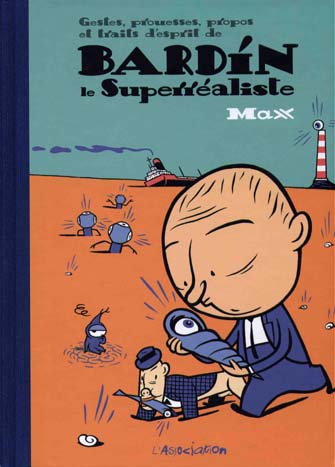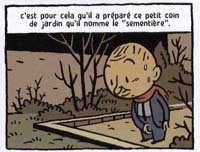 Home > Bart Beaty's Conversational Euro-Comics
Home > Bart Beaty's Conversational Euro-Comics Bardin le Superrealiste, Max
posted July 13, 2006
Bardin le Superrealiste, Max
posted July 13, 2006


The Spanish cartoonist
Max has one of the most disproportionate talent to recognition ratios of any cartoonist published in the English language. Despite having been translated by
Drawn and Quarterly in the 1990s, Max remains almost completely unknown in the American comics scene. While his work over the past decade has been widely anthologized across Europe, very little of his recent work has been seen on this side of the Atlantic. Fortunately, that absence is in the process of being corrected. The release later this month of
Bardin the Superrealist (
Fantagraphics) will collect a large number of the
Bardin stories into one place for the uninitiated. Already, it's a strong contender for best book of the year.

It's been six long years since Drawn and Quarterly released Max' last graphic novel,
The Extended Dream of Mr. D. For the better part of a decade, Max has been telling short stories about a new character in the dream world,
Bardin the Superrealist. Bardin, a big-headed balding man in a suit, is blessed with mystical powers that put him in touch with his own unconscious as well as the global (universal) unconscious mind. Guided by
Dali and Bunuel's
Chien Andalou, Bardin moves through multiple worlds, debating the holy trinity in its many forms, and ruminating on his own philosophical beliefs. Bardin is a psychic everyman, negotiating the world of the subliminal, the mystic, and the miraculous.
The new hardcover
Bardin collection is being produced around the world at the same time, in Spanish by
La Cupula, in English by
Fantagraphics, in French by
L'Association (the edition that I'm basing these comments on), in Dutch by
Oog & Blik, and lord only knows who else in other languages. It's a fantastic little full-color volume. The L'Asso edition has a cloth spine that I hope is maintained by Fantagraphics, as I've always loved this look since I saw it on the Artefact published books (which included work by Max) back in the 1980s. The interior production is spectacular, with vivid colors and a lovely coated paper that brings the material to life. I've seen the originals for a substantial amount of this work, and absolutely nothing has been lost in the process of bringing it to the page. The L'Association edition is one of the nicest books in their catalogue (which is saying a lot), and it should be one of the nicest in the FBI catalogue as well.

As for the work itself, it is charming, funny, joyful, witty, and, of course, more than a little surreal. The bulk of the book is composed of short works, ranging from single page strips to short stories of four or five pages. In these works, Bardin, as a possible stand-in for the artist, explores a highly personal cosmogony. Max, who is one of the great illustrators in comics, presents the world(s) of Bardin with thick, bold lines and vivid colors reminiscent of animation traditions (and one of the gods in the book recalls a certain big-eared Disney mascot). Indeed, Max has worked in animation, and the two-page strip presented here, "Hommage to Mr. Luis Bunuel," is derived from a short animated film by the artist. Overall, this is a gorgeous looking book, the product of one of the strongest visual stylists currently working in the medium.
The second half of the book departs from the first insofar as it presents a single, long story (new for this collection). This thirty-page wordless dream work is a visual tour-de-force, with Bardin combating a wide array of mystical and demonic forces in a quest to slay his own nightmares. This is a charming work, although it comes as a total and complete reversal of the aesthetics of the first half of the book, which has some very text intensive moments. In some ways, the wordless story could have been released as its own work, although it is nice to have the material under one cover.

While
Bardin the Superrealist is not a complete collection of the
Bardin work (the most substantial
Bardin piece not included is the epic narrative corpse comics orchestrated by Max and published as
Bardin Baila con la mas fea (Medio Muerto, 2000), it would be hard to imagine a better one. Beautifully crafted and lovingly realized, if there is any justice in the comics world this will be the most talked about book at
San Diego.
*****
To learn more about Dr. Bart Beaty, or to contact him,
try here.
Those interested in buying comics talked about in Bart Beaty's articles might try
here or
here.


